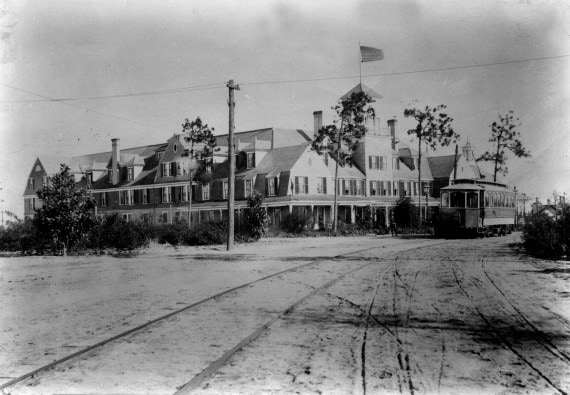By Leah Hughes
On New Year’s Eve in 1895, The Holly Inn welcomes its first guests. For $3 apiece, 20 people send out the old and usher in the new at this hotel in the pine barrens of North Carolina’s Sandhills.
As guests step into the lobby, onto native heart-of pine-floors, they take in the relaxed elegance of floral motif carvings, stenciled ceilings, art glass fixtures and decorative tile. The interior details reflect landscape designer Frederick Law Olmsted’s commitment to nature.
Located in the heart of The Village of Pinehurst, the Holly mixes architectural styles: Part Queen Ann Revival, part Arts and Crafts, part Art Nouveau. All of it — the Holly Inn, the surrounding property with abundant foliage and winding pathways — is a product of Pinehurst founder James Walker Tufts’ vision for this winter retreat. On the eve of a New Year, this place — soon to become the home of American golf and one of the most storied resorts in the country — begins a legacy of hospitality that will continue for decades.
Changing Times
The Holly has been enchanting guests since that first New Year’s Eve in 1895. In those days, the hotel boasted all of the modern amenities of the time: electric lights, steam heat, telephones, a solarium, billiard room and the “best hair mattresses.”country.

Although much has changed since the Holly’s founding, it remains a Village focal point.
Originally founded as a retreat from Northern winters, Pinehurst’s season ran from November 1 to April 30. The Holly reached its capacity by springtime of the first year.
Expansions were made the next several years. The 1898 season saw the addition of a new music room where an orchestra performed daily.
A story from The Pinehurst Outlook on Dec. 2, 1898, touted: “The Inn as it stands today is one of the best-equipped hotels in the country. While not as large as some, for comfort, excellence of appointments and convenience, it is second to none.”
Through the years, the inn evolved. Perhaps its most unexpected role came in the mid-’40s. In 1943, it was home to officers and their families when Camp Mackall was short on housing. Then in the summer of 1944, The Holly was the site of an Army-conducted study of the common cold. Conscientious objectors from Fort Bragg, who had religious objections to war, volunteered as guinea pigs for the experiment.
The inn struggled in the 1970s as newer, more modern accommodations caught the eye of travelers. The Holly closed for a period, and its future was uncertain — but after extensive renovations, it reopened in 1986. The meticulous restoration preserved the inn’s finest features, and it was designated a National and State Historic Landmark.
A Seat on the Porch
A black-and-white photo inside the Tufts Archives — the treasure trove of Pinehurst history located across the street — shows women in full-length dresses and jackets lounging on The Holly’s porch. A man stands beside them in a suit and tie. On a recent weekday,
On a recent weekday, two women drop their shopping bags by rocking chairs on The Holly’s porch and sit down with glasses of wine.
In The Holly’s century-plus history, fashions have come and gone. Modern technology has evolved from a single typewriter and telephones, to data ports, to wireless Internet. Hair mattresses have been replaced with feather-top bedding. But The Holly’s innate sense of relaxation has remained. And guests return in search of that same feeling.

